I wanted to create a model that would describe the behaviour of my data. I tried the simple linear regression, simple polynomial regression and polynomial regression with regularization and cross-validation.
I found that the last method allows an automatic feature selection (with degrees), which I actually need as the simple linear regression does not perform well. I followed this explanation to perform polynomial regression with Lasso regularization and cross-validation.
In this example, this method is used to avoid overfitting which happens if you use a simple polynomial regression. In my case, however, it seems that it vice versa caused overfitting.
I was wondering whether somebody could help me to understand what I am doing wrong in the code implementation? Or maybe there is a better solution on how best fit data into a model?
Code (linear regression with statsmodels, polynomial regressions with scikit learn):
import pandas as pd
import matplotlib.pyplot as plt
import statsmodels.api as sm
from pandas import DataFrame
from sklearn.metrics import mean_squared_error
from sklearn.metrics import mean_absolute_error
# Import function to automatically create polynomial features
from sklearn.preprocessing import PolynomialFeatures
# Import Linear Regression and a regularized regression function
from sklearn.linear_model import LinearRegression
from sklearn.linear_model import LassoCV
#Initial data
SoH = {'Cycle': [1, 2, 3, 4, 5, 6, 7, 8, 9, 10, 11, 12, 13, 14, 15, 16, 17, 18, 19, 20, 21, 22, 23, 24, 25, 26, 27, 28, 29, 30, 31, 32],
'Internal_Resistance': [0.039684729, 0.033377614, 0.031960606, 0.03546798, 0.036786229, 0.03479803, 0.026613861, 0.028650246, 0.028183795, 0.035455215, 0.029205355, 0.033891692, 0.026988849, 0.025647298, 0.033970376, 0.03172454, 0.032437203, 0.033771218, 0.030939938, 0.036919977, 0.027832869, 0.028602469, 0.023065191, 0.028890529, 0.026640394, 0.031488253, 0.02865842, 0.027648949, 0.026217822, 0.032549629, 0.025744309, 0.027945824],
'CV_Capacity': [389.9270401, 307.7366414, 357.6412139, 192.134787, 212.415946, 204.737916, 166.506029, 157.826878, 196.432589, 181.937188, 192.070363, 209.890964, 198.978988, 206.126864, 185.631644, 193.776497, 200.61431, 174.359373, 177.503285, 174.07905, 170.654873, 184.528031, 208.065379, 210.134795, 208.199237, 184.693507, 193.00402, 191.913131, 196.610972, 194.915587, 183.209067, 182.41669],
'Full_Capacity': [1703.8575, 1740.7017, 1760.66, 1775.248302, 1771.664053, 1781.958089, 1783.2295, 1784.500912, 1779.280477, 1780.175547, 1800.761265, 1789.047162, 1791.763677, 1787.014667, 1796.520256, 1798.349587, 1791.776304, 1788.892761, 1791.990303, 1790.307248, 1796.580484, 1803.89133, 1793.305294, 1784.638742, 1780.056339, 1783.081746, 1772.001436, 1794.182046, 1777.880947, 1792.21646, 1785.653845, 1788.401923]
}
Test = {'Cycle': [33, 34, 35],
'Internal_Resistance': [0.027332509, 0.027960729, 0.028969193],
'CV_Capacity': [204.018257, 179.929472, 189.576431],
'Full_Capacity': [1782.983718, 1793.939504, 1788.67233]
}
#Initial data presented in a form of a data frame
df = DataFrame(SoH,columns=['Cycle','Internal_Resistance','CV_Capacity','Full_Capacity'])
df1 = DataFrame(SoH,columns=['Cycle','Internal_Resistance','CV_Capacity'])
X = df1.to_numpy()
print(df.head(32))
print()
print(X)
print()
#Plot the Full Capacity vs predictors (Cycle, Internal Resistance and CV Capacity)
for i in df.columns:
df.plot.scatter(i,'Full_Capacity', edgecolors=(0,0,0),s=50,c='g',grid=True)
# Fitting data with statsmodels
X1 = df[['Cycle','Internal_Resistance','CV_Capacity']]
Y1 = df['Full_Capacity']
X1 = sm.add_constant(X1.values) # adding a constant
model = sm.OLS(Y1, X1).fit()
predictions = model.predict(X1)
print_model = model.summary()
print(print_model)
print()
# Fitting data with scikit learn - simple linear regression
linear_model = LinearRegression(normalize=True)
X_linear=df.drop('Full_Capacity',axis=1)
y_linear=df['Full_Capacity']
linear_model.fit(X_linear,y_linear)
y_pred_linear = linear_model.predict(X_linear)
#Metrics of the linear model
MAE_linear = mean_absolute_error(y_linear, y_pred_linear)
print("Mean absolute error of linear model:",MAE_linear)
MSE_linear = mean_squared_error(y_linear, y_pred_linear)
print("Mean-squared error of linear model:",MSE_linear)
RMSE_linear = np.sqrt(MSE_linear)
print("Root-mean-squared error of linear model:",RMSE_linear)
#Coefficients for the linear model
coeff_linear = pd.DataFrame(linear_model.coef_,index=df.drop('Full_Capacity',axis=1).columns, columns=['Linear model coefficients'])
print(coeff_linear)
print ("R2 value of linear model:",linear_model.score(X_linear,y_linear))
#Plot predicted values vs actual values
plt.figure(figsize=(12,8))
plt.xlabel("Predicted value with linear fit",fontsize=20)
plt.ylabel("Actual y-values",fontsize=20)
plt.grid(1)
plt.scatter(y_pred_linear,y_linear,edgecolors=(0,0,0),lw=2,s=80)
plt.plot(y_pred_linear,y_pred_linear, 'k--', lw=2)
#Fitting data with a simple polynomial model
poly = PolynomialFeatures(2,include_bias=False)
X_poly = poly.fit_transform(X)
X_poly_feature_name = poly.get_feature_names(['Feature'+str(l) for l in range(1,4)])
print(X_poly_feature_name)
print(len(X_poly_feature_name))
df_poly = pd.DataFrame(X_poly, columns=X_poly_feature_name)
print(df_poly.head())
df_poly['y']=df['Full_Capacity']
print(df_poly.head())
X_train=df_poly.drop('y',axis=1)
y_train=df_poly['y']
poly = LinearRegression(normalize=True)
model_poly=poly.fit(X_train,y_train)
y_poly = poly.predict(X_train)
#Metrics of the polynomial model
MAE_poly = mean_absolute_error(y_poly, y_train)
print("Mean absolute error of simple polynomial model:",MAE_poly)
MSE_poly = mean_squared_error(y_poly, y_train)
print("Mean-squared error of simple polynomial model:",MSE_poly)
RMSE_poly = np.sqrt(MSE_poly)
print("Root-mean-squared error of simple polynomial model:",RMSE_poly)
print ("R2 value of simple polynomial model:",model_poly.score(X_train,y_train))
coeff_poly = pd.DataFrame(model_poly.coef_,index=df_poly.drop('y',axis=1).columns, columns=['Coefficients polynomial model'])
print(coeff_poly)
#Fitting data with a polynomial model with regularization and cross-validation
model1 = LassoCV(cv=10,verbose=0,normalize=True,eps=0.001,n_alphas=100, tol=0.0001,max_iter=10000)
model1.fit(X_train,y_train)
y_pred1 = np.array(model1.predict(X_train))
#Metrics of the polynomial model with regularization and cross-validation
MAE_1 = mean_absolute_error(y_pred1, y_pred1)
print("Mean absolute error of the new polynomial model:",MAE_1)
MSE_1 = mean_squared_error(y_pred1, y_pred1)
print("Mean-squared error of the new polynomial model:",MSE_1)
RMSE_1 = np.sqrt(MSE_1)
print("Root-mean-squared error of the new polynomial model:",RMSE_1)
coeff1 = pd.DataFrame(model1.coef_,index=df_poly.drop('y',axis=1).columns, columns=['Coefficients Metamodel'])
print(coeff1)
print ("R2 value of the new polynomial model:",model1.score(X_train,y_pred1))
print ("Alpha of the new polynomial model:",model1.alpha_)
print(coeff1[coeff1['Coefficients Metamodel']!=0])
plt.figure(figsize=(12,8))
plt.xlabel("Predicted value with Metamodel",fontsize=20)
plt.ylabel("Actual y-values",fontsize=20)
plt.grid(1)
plt.scatter(y_pred1,y_train,edgecolors=(0,0,0),lw=2,s=80)
plt.plot(y_pred1,y_pred1, 'k--', lw=2) ```

